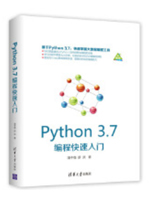给网友朋友们带来一篇相关的编程文章,网友沈娅欣根据主题投稿了本篇教程内容,涉及到Python 3.7、dataclass、装饰器、Python 3.7的dataclass装饰器用法相关内容,已被423网友关注,涉猎到的知识点内容可以在下方电子书获得。
Python 3.7的dataclass装饰器用法
Python 3.7新功能之dataclass装饰器详解
前言
Python 3.7 将于今年夏天发布,Python 3.7 中将会有许多新东西:
- 各种字符集的改进
- 对注释的推迟评估
- 以及对dataclass的支持
最激动人心的新功能之一是 dataclass 装饰器。
什么是 Data Class
大多数 Python 开发人员编写过很多像下面这样的类:
class MyClass: def __init__(self, var_a, var_b): self.var_a = var_a self.var_b = var_b
dataclass 可以为简单的情况自动生成方法,例如,一个__init__接受这些参数并将其分配给自己,之前的小例子可以重写为:
@dataclass class MyClass: var_a: str var_b: str
那么通过一个例子来看看如何使用吧
星球大战 API
可以使用 requests 从星球大战 API 获取资源:
response = requests.get('https://swapi.co/api/films/1/')
dictionary = response.json()
让我们来看看 dictionary (简化过)的结果:
{
'characters': ['https://swapi.co/api/people/1/',… ],
'created': '2014-12-10T14:23:31.880000Z',
'director': 'George Lucas',
'edited': '2015-04-11T09:46:52.774897Z',
'episode_id': 4,
'opening_crawl': 'It is a period of civil war.\r\n … ',
'planets': ['https://swapi.co/api/planets/2/', … ],
'producer': 'Gary Kurtz, Rick McCallum',
'release_date': '1977-05-25',
'species': ['https://swapi.co/api/species/5/',…],
'starships': ['https://swapi.co/api/starships/2/',…],
'title': 'A New Hope',
'url': 'https://swapi.co/api/films/1/',
'vehicles': ['https://swapi.co/api/vehicles/4/',…]
封装 API
为了正确地封装一个 API,我们应该创建一个用户可以在其应用程序中使用的对象,因此,在Python 3.6 中定义一个对象来包含requests对 /films/endpoint的响应:
class StarWarsMovie: def __init__(self, title: str, episode_id: int, opening_crawl: str, director: str, producer: str, release_date: datetime, characters: List[str], planets: List[str], starships: List[str], vehicles: List[str], species: List[str], created: datetime, edited: datetime, url: str ): self.title = title self.episode_id = episode_id self.opening_crawl= opening_crawl self.director = director self.producer = producer self.release_date = release_date self.characters = characters self.planets = planets self.starships = starships self.vehicles = vehicles self.species = species self.created = created self.edited = edited self.url = url if type(self.release_date) is str: self.release_date = dateutil.parser.parse(self.release_date) if type(self.created) is str: self.created = dateutil.parser.parse(self.created) if type(self.edited) is str: self.edited = dateutil.parser.parse(self.edited)
仔细的读者可能已经注意到这里有一些重复的代码。
这是使用 dataclass 装饰器的经典案例,我们需要创建一个主要用来保存数据的类,只需一点验证,所以让我们来看看我们需要修改什么。
首先,data class 自动生成一些 dunder 方法,如果我们没有为 data class 装饰器指定任何选项,则生成的方法有:__init__,__eq__和__repr__,如果你已经定义了__repr__但没定义__str__,默认情况下 Python(不仅仅是 data class)将实现返回__repr__的输出__str__方法。因此,只需将代码更改为以下代码即可实现四种 dunder 方法:
@dataclass class StarWarsMovie: title: str episode_id: int opening_crawl: str director: str producer: str release_date: datetime characters: List[str] planets: List[str] starships: List[str] vehicles: List[str] species: List[str] created: datetime edited: datetime url: str
我们去掉了__init__方法,以确保 data class 装饰器可以添加它生成的对应方法。不过,我们在这个过程中失去了一些功能,我们的 Python 3.6 构造函数不仅定义了所有的值,还试图解析日期,我们怎样才能用 data class 来做到这一点呢?
如果要覆盖 __init__,我们将失去 data class 的优势,因此,如果要处理任何附加功能可以使用新的 dunder 方法:__post_init__,让我们看看__post_init__方法对于我们的包装类来说是什么样子的:
def __post_init__(self): if type(self.release_date) is str: self.release_date = dateutil.parser.parse(self.release_date) if type(self.created) is str: self.created = dateutil.parser.parse(self.created) if type(self.edited) is str: self.edited = dateutil.parser.parse(self.edited)
就是这样! 我们可以使用 data class 装饰器在用三分之二的代码量实现我们的类。
更多好东西
通过使用装饰器的选项,可以为用例进一步定制 data class,默认选项是:
@dataclass(init=True, repr=True, eq=True, order=False, unsafe_hash=False, frozen=False)
- init决定是否生成__init__ dunder 方法
- repr决定是否生成__repr__ dunder方法
- eq对__eq__ dunder 方法也是如此,它决定相等性检查的行为(your_class_instance == another_instance)
- order 实际上创建了四种 dunder 方法,它们确定所有检查小于,and/or,大于的行为,如果将其设置为 true,则可以对对象列表进行排序。
最后两个选项确定对象是否可以被哈希化,如果你想使用你的 class 的对象作为字典键的话,这是必要的。
更多信息请参考:PEP 557 -- Data Classes
python类装饰器用法实例
本文实例讲述了python类装饰器用法。分享给大家供大家参考。具体如下:
#!coding=utf-8
registry = {}
def register(cls):
registry[cls.__clsid__] = cls
return cls
@register
class Foo(object):
__clsid__ = '123-456'
def bar(self):
pass
print registry
运行结果如下:
{'123-456': <class '__main__.Foo'>}
希望本文所述对大家的Python程序设计有所帮助。
Python 使用类写装饰器的小技巧
最近学到了一个有趣的装饰器写法,就记录一下。
装饰器是一个返回函数的函数。写一个装饰器,除了最常见的在函数中定义函数以外,Python还允许使用类来定义一个装饰器。
1、用类写装饰器
下面用常见的写法实现了一个缓存装饰器。
def cache(func):
data = {}
def wrapper(*args, **kwargs):
key = f'{func.__name__}-{str(args)}-{str(kwargs)})'
if key in data:
result = data.get(key)
print('cached')
else:
result = func(*args, **kwargs)
data[key] = result
print('calculated')
return result
return wrapper
看看缓存的效果。
@cache def rectangle_area(length, width): return length * width rectangle_area(2, 3) # calculated # 6 rectangle_area(2, 3) # cached # 6
装饰器的@cache是一个语法糖,相当于func = cache(func),如果这里的cache不是一个函数,而是一个类又会怎样呢?定义一个类class Cache, 那么调用func = Cache(func)会得到一个对象,这时返回的func其实是Cache的对象。定义__call__方法可以将类的实例变成可调用对象,可以像调用函数一样调用对象。然后在__call__方法里调用原本的func函数就能实现装饰器了。所以Cache类也能当作装饰器使用,并且能以@Cache的形式使用。
接下来把cache函数改写为Cache类:
class Cache:
def __init__(self, func):
self.func = func
self.data = {}
def __call__(self, *args, **kwargs):
func = self.func
data = self.data
key = f'{func.__name__}-{str(args)}-{str(kwargs)})'
if key in data:
result = data.get(key)
print('cached')
else:
result = func(*args, **kwargs)
data[key] = result
print('calculated')
return result
再看看缓存结果,效果一样。
@Cache def rectangle_area(length, width): return length * width rectangle_area(2, 3) # calculated # 6 rectangle_area(2, 3) # cached # 6
2、装饰类的方法
装饰器不止能装饰函数,也经常用来装饰类的方法,但是我发现用类写的装饰器不能直接用在装饰类的方法上。(有点绕…)
先看看函数写的装饰器如何装饰类的方法。
class Rectangle:
def __init__(self, length, width):
self.length = length
self.width = width
@cache
def area(self):
return self.length * self.width
r = Rectangle(2, 3)
r.area()
# calculated
# 6
r.area()
# cached
# 6
但是如果直接换成Cache类会报错,这个错误的原因是area被装饰后变成了类的一个属性,而不是方法。
class Rectangle:
def __init__(self, length, width):
self.length = length
self.width = width
@Cache
def area(self):
return self.length * self.width
r = Rectangle(2, 3)
r.area()
# TypeError: area() missing 1 required positional argument: 'self'
Rectangle.area
# <__main__.Cache object at 0x0000012D8E7A6D30>
r.area
# <__main__.Cache object at 0x0000012D8E7A6D30>
回头再来看看没有装饰器的情况,Python在实例化对象后把函数变成了方法。
class Rectangle:
def __init__(self, length, width):
self.length = length
self.width = width
def area(self):
return self.length * self.width
Rectangle.area
# <function Rectangle.area at 0x0000012D8E7B28C8>
r = Rectangle(2, 3)
r.area
# <bound method Rectangle.area of <__main__.Rectangle object
因此解决办法很简单,要用类写的装饰器来装饰类的方法,只需要把可调用对象包装成函数就行。
# 定义一个简单的装饰器,什么也不做,仅仅是把可调用对象包装成函数
def method(call):
def wrapper(*args, **kwargs):
return call(*args, **kwargs)
return wrapper
class Rectangle:
def __init__(self, length, width):
self.length = length
self.width = width
@method
@Cache
def area(self):
return self.length * self.width
r = Rectangle(2, 3)
r.area()
# calculated
# 6
r.area()
# cached
# 6
或者用@property还能直接把方法变成属性。
class Rectangle:
def __init__(self, length, width):
self.length = length
self.width = width
@property
@Cache
def area(self):
return self.length * self.width
r = Rectangle(2, 3)
r.area
# calculated
# 6
r.area
# cached
# 6
总结
用类写装饰器并非什么特别的技巧,一般情况下确实没必要这么写,不过这样就可以用一些类的特性来写装饰器,比如类的继承,也算是提供了另一种思路吧。










